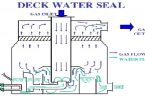Objectives
- The purpose of the VOC management plan is to ensure that the operation of a tanker, to which regulation 15 of MARPOL Annex VI applies, prevents or minimizes VOC emissions to the extent possible.
- Emissions of VOCs can be prevented or minimized by:
- optimizing operational procedures to minimize the release of VOC emissions; and/or
- using devices, equipment, or design changes to prevent or minimize VOC emissions.
- To comply with this plan, the loading and carriage of cargoes which generate VOC emissions should be evaluated and procedures written to ensure that the operations of a ship follow best management practices for preventing or minimizing VOC emissions to the extent possible. If devices, equipment, or design changes are implemented to prevent or minimize VOC emissions, they shall also be incorporated and described in the VOC management plan as appropriate.
- While maintaining the safety of the ship, the VOC management plan should encourage and, as appropriate, set forth the following best management practices:
- the loading procedures should take into account potential gas releases due to low pressure and, where possible, the routing of oil from crude oil manifolds into the tanks should be done so as to avoid or minimize excessive throttling and high flow velocity in pipes;
- the ship should define a target operating pressure for the cargo tanks. This pressure should be as high as safely possible and the ship should aim to maintain tanks at this level during the loading and carriage of relevant cargo;
- when venting to reduce tank pressure is required, the decrease in the pressure in the tanks should be as small as possible to maintain the tank pressure as high as possible;
- the amount of inert gas added should be minimized. Increasing tank pressure by adding inert gas does not prevent VOC release but it may increase venting and therefore increased VOC emissions; and
- when crude oil washing is considered, its effect on VOC emissions should be taken into account. VOC emissions can be reduced by shortening the duration of the washing or by using a closed cycle crude oil washing programme.
Additional considerations
- A person in charge of carrying out the plan
- A person shall be designated in the VOC management plan to be responsible for implementing the plan and that person may assign appropriate personnel to carry out the relevant tasks;
- Procedures for preventing or minimizing VOC emissions
- Ship-specific procedures should be written or modified to address relevant VOC emissions, such as the following operations:
- Loading;
- Carriage of relevant cargo; and
- Crude oil washing;
- If the ship is equipped with VOC reduction devices or equipment, the use of these devices or equipment should be incorporated into the above procedures as appropriate.
- Ship-specific procedures should be written or modified to address relevant VOC emissions, such as the following operations:
Designated Person
A person should be designated to assume overall charge of the VOC management on board the ship.
The designated person should preferably have:



